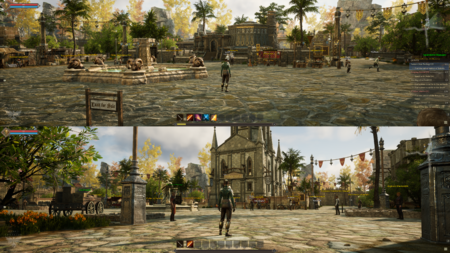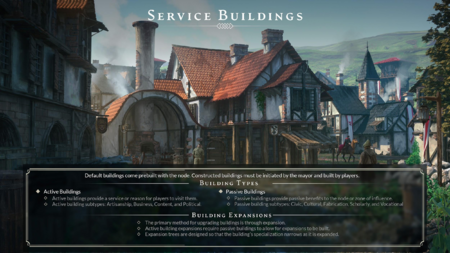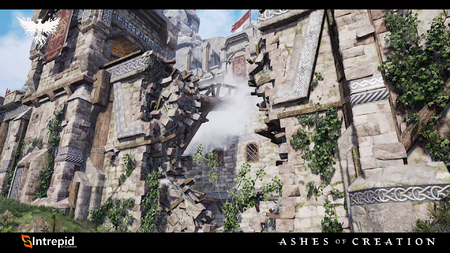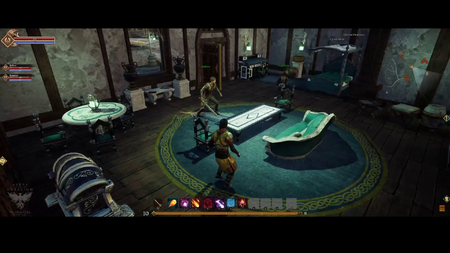Node layout and style

The layout and architecture within a Node’s development area are determined by influential race. For example, a stage 3 Node with the majority of player contribution being Py'rai would have a Py'rai village with Py'rai architecture. Most NPCs would be Py'rai elves, and offer questlines within the Py'rai narrative.[1] – Margaret Krohn
Each player’s contributed experience is flagged with their character race and other identifiers. When a Node advances, the race with the highest experience contribution determines the Node’s style and culture. This style and culture change can happen at every Node Stage. For example, if a Node advances to Level 2 - Encampment Stage and 51% of all experience was earned by Ren’Kai players, the Node will be a Level 2 Ren’Kai Node. If that same Node advances to a Level 3 - Village Stage Node, but the Py'Rai contributed 62% of all the experience earned, then the Node will be a Level 3 Py'Rai Node.[2] – Margaret Krohn
Node layout and style is determined by several factors:[3][4]
- The way that the node system is built is that they can exist across a spread of 18 biomes, but at the same time have to represent the cultural influence of these cultures that are intrinsically a part of a specific biome.[5] – Steven Sharif
- Environment (biome) and location of the node.[5][3][4]
- Nodes will adjust the local topography to fit the aesthetic and mechanical requirements of the node.[6]
- Currently the way that the platform system is set up, is it's capable of adjusting the topography of the node's footprint, regardless of the surrounding terrain. So the reason for that is we want to have flexibility in the presentation of the node's layout and how it is essentially both from an aesthetic standpoint as well as a mechanical standpoint with node sieges- how it's constructed and that construction should have the ability to take on a variance of different types of topography. So it shouldn't be dependent on the surrounding area. Now that's not to say that the surrounding area isn't going to have some influence over. So for example... we're experimenting a little bit with the platform tech and putting up a node up against the side of a mountain or on the edge of a cliff or something that has a beautiful vista. Those are things that we're going to test out obviously as we continue to work on the node tool and how that platform system works, but the idea is to have the node independent of the surrounding terrain.[6] – Steven Sharif
- Some parts are determined by the area it's in. Some parts are determined by the type it is. Some parts are determined by the race it is; and then the rest of it is determined by the mayor.[4] – Jeffrey Bard
- Race that contributed the highest percentage to the node's advancement will alter the racial appearance of its buildings, NPCs, and props.[7][8][3][2][4][9][10]
- All nodes, whether they're associated with a castle or associated with normal node structure, has cultural influences that replicate over to the buildings that are produced and the NPCs that are present.[12] – Steven Sharif
- The rest is determined by the node's mayor.[4]
- It should be possible for a node to complete several building projects within a mayor's one month term in office.[13]
- Q: How long would you say it will take players on average to fill/build up a node completely from wilderness to metropolis?
- A: It's one thing to get a node to a certain level: it's another thing to develop the node; and I can't really give you an on-average expectation, because there's a lot of variables at play. There's how many citizens does the node have attracted to it; what's the type of traffic that the node is attracting to it based on things like its tax rates, or the specialization that it chose to spec into, based on the building types it's chosen to build. All of those things are variables that can affect the quote-unquote "average build-out time" of a particular node. So it's difficult to give you an average when there's so many variables along those lines. But the idea is that if there is a particular project that players are interested in in developing based on the node stage, that they would have the ability to complete several of those projects as within a single term of a mayor; and a term of a mayor is one month.[13] – Steven Sharif
Node buildings

The important thing with the service building system for us is that it's a way to shape your node like a character; and to give you an exclusive niche that you can carve out in the world; or a niche that you fight over. If you go down this weaponsmithing path and you build your node to be this mecca of weaponsmithing and the node three doors down builds it, there's reason for you to conflict over it. They're taking your business. Or maybe you are in a zone and there isn't a weaponsmithing thing anywhere near you, and you do want to start to carve that path for yourself to make your node a place people visit and come to.[15] – Chris Justo
Service buildings within a node are either default buildings that come with the node, or they are constructed buildings, which are initiated by the mayor and built by players.[14][15][16][17][18][19][20] Service buildings are further broken down into two main types:[14][15]
- Active service buildings are service buildings that players directly interact with. These are further broken down into Artisanship, Business, Content, and Political categories.[14][15]
- Passive service buildings provide passive benefits to the node or its zone of influence. These buildings are broken down into Civic, Cultural, Fabrication, Scholarly, and Vocational.[14][15]
- Constructed service buildings are available to every type of node in every location. Where the uniqueness comes in is in some of the default buildings like your node-type building.[21] – Chris Justo
Service buildings are upgraded by expansions, which are unlocked through the placement of passive service buildings.[14][15]
- Building expansions unlock higher tier workstations at the cost of dedicating service building plots.[22][18]
- Node service building expansions specialize the building through a tech tree based on the stage of the node.[23][24]
Service buildings incur a regular maintenance cost of node commodities and gold from the node treasury in order to continue operations.[14][25]
Unique node buildings
Each node type has a unique service building associated with it that can be activated at Village (stage 3) of node advancement.[21] The unique building plays a central role in the progress of civilization for a server.[27]
Node building destruction

You could be more precision oriented in the decision to attack a city. Let's say it's a rival node that's trying to reach a node stage five or something and you want to disable their ability for the religious system to progress so you target the temple during the attack, or you want to disable their scholars academy from reaching a higher level so that your nodes can; or you want to disable multiple buildings that allow for experience and quests to be undertaken by its citizenship, which prevents them from keeping up in pace of experience gained with your node. These can be more precision oriented and don't have to effectualize an actual takeover of the node.[29] – Steven Sharif
Node buildings (including player housing) have hit points and can be damaged or destroyed by different systems.[24][30]
- NPC-driven events that are a response to story arcs or node atrophy.[24]
- Node sieges and node wars.[24]
- Attackers may not be capable of destroying a node during a siege. Instead they may carry out precision attacks to disable specific service-oriented buildings within the node. These buildings can be targeted with siege weapons and bombs.[29]
- Hazardous events such as tornadoes or hurricanes.[31][24]
- Mayors have the ability to demolish constructed node buildings. This will have a node mandate cost and will require player buy-in via a vote.[14][25]
- Mayors will also have the ability, if they want, to demolish constructed buildings. So if they if they so choose they can destroy a building if they don't think it's needed anymore. But this will have mandate cost and a player buy-in votes. So we want to make sure that [the] mayor can't just go and blow up the whole node if they're trying to grief or something. So this is very important and impactful decision.[14][25] – John Collins
If building maintenance is not paid, or a building is damaged as the result of an event or siege, the building will enter a state of disarray.[14][25] Any NPCs or services offered by that building will not be available until the building is repaired.[17][30]
- Players must contribute materials to repair disarrayed buildings and restore them to an operational state.[14][25][24][30][32]
If a node siege is successful, or if buildings otherwise take significant damage, they are destroyed and appear as rubble on the plot they occupied.[14][25][24]
- Node governments must clear any rubble on plots before any buildings can be reconstructed. Any prerequisites for the building reconstruction must be satisfied beforehand.[24]
- Buildings also live within a prerequisite system. So in order to build down the tech tree of what these buildings provide, as the node grows larger to access stronger building types, you may get a kink in that chain if it's destroyed and you'll have to stand that back up in order to support the service again.[24] – Steven Sharif
- If the node is destroyed by a node siege, the debris field will contain spoils that are lootable by attackers or defenders.[33][34][35][30][36][37]
- Player housing that is destroyed during a node siege can no longer be sold.[38] Furnishing and decorations are retained and can be placed again later.[38][39][40]
Static housing development

If the node advances players can essentially select an option on their house as they own it that they want it to upgrade to the next stage if the node advances or they can select an option not to upgrade it. So you as the node levels and larger homes become available, the town stage introduces additional medium types housing, the city stage introduces large sized homes, and in the metropolis stage introduces my mansion size houses each of which contain specific... allowances and allotments for different types of furnishings that have gameplay implications.[41] – Steven Sharif
In-node housing can scale in size with the advancement of its parent node. This may be toggled on or off by the player.[41][42]
- The Village stage offers small housing types.[41]
- The Town stage introduces medium housing types.[41]
- The City stage introduces large sized homes.[41]
- The Metropolis stage introduces mansion size houses.[41]
If you choose to keep the same size then the next stage will have an occupied small home. So for instance if at stage three there are 8 small home and you own 1, then at stage 4 there are 10 new small homes of which x are owned by previous owners, and 10 new medium homes of which x are owned by upgraded small home owners.[43] – Steven Sharif
New property becomes available at each stage of advancement, but it will be more akin to what was available at the previous stage.[42]
- Only the houses that existed at the Village stage will become main street mansions at the Metropolis stage.[42]
Node redevelopment
A node that was successfully destroyed by a node siege may develop differently due to the following influences:[3][44]
- Different races becoming primary contributors.[3][44]
- Design elements determined by different governments.[3][44]
- Reactions and interactions with other nodes in the world.[3][44]
Artistic style

Part of the biome that the Ren'Kai are accustomed to is a more swamp or marsh oriented, so they have these almost stilt-like foundations on some of the assets because they're intended to sit above that marsh.[45] – Steven Sharif
Ashes of Creation will have a higher graphical fidelity than most western games. It will not be too stylized or "cartoony".[46]
- We can push the limits a little bit on the graphical fidelity, especially using Unreal Engine 4... My desire was not to see very cartoony games. I'm not a big fan of highly stylized art.[46] – Steven Sharif
- It's not to say that people can't do steampunk well. I've enjoyed some steampunk stuff. I'm a very high fantasy oriented type of storyteller; and the inspiration for Ashes obviously comes from my pathfinder campaigns that I ran long ago; and those are always set in a high fantasy world. So it just compromises what I believe is the perspective of the storytelling in the environment.[47] – Steven Sharif
- Intrepid Studios does not use AI for art production.[48]
- We do not use AI for production, except in unique internal cases when communicating fast reference material.[48] – Steven Sharif
Artistic influences

Character races are super important. These are the choices that we make at the onset of our adventure in an MMORPG: what race- not just mechanically aligns with our decisions, if those races have game mechanics behind them from a stat perspective, but visually and culturally and historically: What are these? What do these races represent? So it's important that visually they're distinct. And everyone's seen fantasy games do Elves, so everyone's seen them do Humans, everyone's seen them do Orcs: There's an established expectation almost behind what these traditional fantasy races represent; and there's a risk, because whenever you're creating a new IP or a new story or a new world- a new Universe; a realm in which things don't have to always be the norm, you can take a little bit of creative liberty to redefine some of the aspects of a particular race; and that can be a good thing, because it's something that is new to players. It's something that is unique to the realm that we're building- the surroundings that you have. So what we wanted to do was push a little bit more on the unique side of what the Py'rai would look like from a visual perspective.[50] – Steven Sharif
- Aelean architecture has a French medieval influence.[51]
- Dünir have a Nordic cultural influence.[52]
- Empyreans have a Greco-Roman imperialistic feeling.[53]
- The Kaelar have a European influence.[54]
- The Niküa have a Polynesian influence.[55][53]
- The Py'Rai have a Navajo Native American influence.[53] Py'Rai architecture has a woodland inspiration.[56][57]
- Pyrian architecture has a Greco-Roman influence.[58]
- Ren'Kai architecture has an Asian influence.[49]
- The Vaelune have a Middle Eastern influence.[59]
- The Vek have a Mesoamerican influence.[59]
- You will see in the different races that are available from a player character standpoint a lot of different influences that reflect many cultures in the world: Not just European, not just Africa, not Mesoamerican. These cultures are going to be present in many of the races.[60] – Steven Sharif
- The idea is just to find a base component in the real world as a starting point and then to begin to fantasize.[51] – Steven Sharif
See also
References
- ↑ Blog - Know Your Nodes - The Basics.
- ↑ 2.0 2.1 2.2 Blog - Know Your Nodes - Advance and Destroy.
- ↑ 3.0 3.1 3.2 3.3 3.4 3.5 3.6 Livestream, October 30, 2020 (39:17).
- ↑ 4.0 4.1 4.2 4.3 4.4 4.5 Livestream, September 27, 2018 (53:06).
- ↑ 5.0 5.1 Livestream, February 25, 2022 (41:00).
- ↑ 6.0 6.1 Livestream, February 26, 2021 (1:12:18).
- ↑ Livestream, March 31, 2022 (4:57).
- ↑ Podcast, April 11, 2021 (29:47).
- ↑ Interview, May 11, 2018 (54:34).
- ↑ Livestream, May 26, 2017 (21:23).
- ↑ Podcast, April 11, 2021 (23:36).
- ↑ 12.0 12.1 Interview, May 11, 2018 (47:27).
- ↑ 13.0 13.1 Livestream, July 29, 2022 (1:13:09).
- ↑ 14.00 14.01 14.02 14.03 14.04 14.05 14.06 14.07 14.08 14.09 14.10 14.11 Blog: Development Update with Village Node.
- ↑ 15.0 15.1 15.2 15.3 15.4 15.5 15.6 Livestream, August 31, 2023 (50:25).
- ↑ Video, August 31, 2023 (2:59).
- ↑ 17.0 17.1 Interview, July 9, 2023 (1:32:45).
- ↑ 18.0 18.1 Livestream, May 19, 2017 (33:57).
- ↑ Livestream, January 20, 2018 (38:17).
- ↑ Livestream, 2018-04-8 (PM) (51:49).
- ↑ 21.0 21.1 Livestream, August 31, 2023 (56:18).
- ↑ Livestream, August 31, 2023 (52:56).
- ↑ Video, August 31, 2023 (34:37).
- ↑ 24.0 24.1 24.2 24.3 24.4 24.5 24.6 24.7 24.8 Livestream, March 31, 2022 (1:13:00).
- ↑ 25.0 25.1 25.2 25.3 25.4 25.5 Livestream, August 31, 2023 (57:23).
- ↑ Livestream, September 1, 2018 (36:28).
- ↑ Know Your Nodes: Economic Node Type.
- ↑ Livestream, October 31, 2019 (36:20).
- ↑ 29.0 29.1 Livestream, November 22, 2019 (16:56).
- ↑ 30.0 30.1 30.2 30.3 Interview, July 8, 2020 (57:46).
- ↑ Forums - Livestream Q&A 2022-08-26.
- ↑ Livestream, November 22, 2019 (17:59).
- ↑ Interview, July 9, 2023 (1:36:24).
- ↑ Livestream, October 14, 2022 (52:31).
- ↑ Podcast, September 29, 2021 (14:21).
- ↑ Livestream, April 30, 2020 (1:14:44).
- ↑

- ↑ 38.0 38.1 Livestream, June 26, 2020 (1:02:12).
- ↑ Livestream, July 18, 2017 (40:14).
- ↑ Livestream, November 17, 2017 (47:10).
- ↑ 41.0 41.1 41.2 41.3 41.4 41.5 41.6 Video, May 31, 2020 (47:32).
- ↑ 42.0 42.1 42.2 Node series part II – the Metropolis.
- ↑

- ↑ 44.0 44.1 44.2 44.3 Livestream, May 24, 2017 (52:39).
- ↑ 45.0 45.1 Livestream, February 25, 2022 (46:17).
- ↑ 46.0 46.1 Interview, October 20, 2018 (2:17:43).
- ↑ 47.0 47.1 Livestream, March 31, 2023 (1:17:42).
- ↑ 48.0 48.1

- ↑ 49.0 49.1 Livestream, October 31, 2019 (40:27).
- ↑ Livestream, February 25, 2022 (49:42).
- ↑ 51.0 51.1 Interview, October 20, 2018 (3:47:17).
- ↑

- ↑ 53.0 53.1 53.2 Interview, May 11, 2018 (1:03:21).
- ↑ Podcast, May 11, 2018 (31:35).
- ↑ Livestream, September 30, 2022 (1:08:24).
- ↑ Livestream, February 25, 2022 (44:28).
- ↑

- ↑ Livestream, October 16, 2017 (15:58).
- ↑ 59.0 59.1 Podcast, May 11, 2018 (31:35).
- ↑ Interview, May 11, 2018 (1:04:27).
